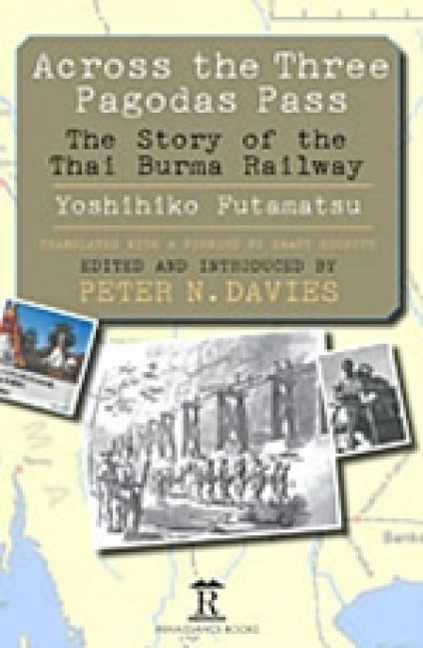Book contents
- Frontmatter
- Dedication
- Contents
- Acknowledgements
- Foreword
- Introduction
- Across the Three Pagodas Pass
- Translator’s Acknowledgements
- Preface
- Chapter 1 Departure for the Front
- Chapter 2 In Indo-China
- Chapter 3 Opening of Hostilities
- Chapter 4 The River Krian
- Chapter 5 The Malayan Campaign
- Chapter 6 The Fall of Singapore
- Chapter 7 Surrender
- Chapter 8 Shōnan: Light of the South
- Chapter 9 The Thai-Burma Railway
- Chapter 10 Preparing Construction
- Chapter 11 Banpong
- Chapter 12 Prisoners-of-War
- Chapter 13 Constructing the Railway
- Chapter 14 Thailand
- Chapter 15 The River Kwae Noi
- Chapter 16 The Mae Khlaung Bridge
- Chapter 17 Kanchanaburi
- Chapter 18 The Jungle
- Chapter 19 From Bangkok to Singapore
- Chapter 20 Rush Construction
- Chapter 21 The Base at Wanyai
- Chapter 22 The Labour Force
- Chapter 23 Survey Unit
- Chapter 24 Test Run
- Chapter 25 Bridge-Building and Shifting Earth
- Chapter 26 The Rainy Season: The Monsoon
- Chapter 27 Kinsaiyok
- Chapter 28 Diseases and Epidemics
- Chapter 29 Cattle Drive
- Chapter 30 Living in the Jungle
- Chapter 31 Soon to the Three Pagodas Pass
- Chapter 32 Towards the Setting Sun
- Chapter 33 Opening to Traffic
- Chapter 34 The Bombing
- Chapter 35 End of the War
- Chapter 36 Internment
- Chapter 37 Repatriation
- Footnote
- Postscript
- End Notes
- Glossary
- Bibliography
- Index
Chapter 10 - Preparing Construction
Published online by Cambridge University Press: 13 May 2022
- Frontmatter
- Dedication
- Contents
- Acknowledgements
- Foreword
- Introduction
- Across the Three Pagodas Pass
- Translator’s Acknowledgements
- Preface
- Chapter 1 Departure for the Front
- Chapter 2 In Indo-China
- Chapter 3 Opening of Hostilities
- Chapter 4 The River Krian
- Chapter 5 The Malayan Campaign
- Chapter 6 The Fall of Singapore
- Chapter 7 Surrender
- Chapter 8 Shōnan: Light of the South
- Chapter 9 The Thai-Burma Railway
- Chapter 10 Preparing Construction
- Chapter 11 Banpong
- Chapter 12 Prisoners-of-War
- Chapter 13 Constructing the Railway
- Chapter 14 Thailand
- Chapter 15 The River Kwae Noi
- Chapter 16 The Mae Khlaung Bridge
- Chapter 17 Kanchanaburi
- Chapter 18 The Jungle
- Chapter 19 From Bangkok to Singapore
- Chapter 20 Rush Construction
- Chapter 21 The Base at Wanyai
- Chapter 22 The Labour Force
- Chapter 23 Survey Unit
- Chapter 24 Test Run
- Chapter 25 Bridge-Building and Shifting Earth
- Chapter 26 The Rainy Season: The Monsoon
- Chapter 27 Kinsaiyok
- Chapter 28 Diseases and Epidemics
- Chapter 29 Cattle Drive
- Chapter 30 Living in the Jungle
- Chapter 31 Soon to the Three Pagodas Pass
- Chapter 32 Towards the Setting Sun
- Chapter 33 Opening to Traffic
- Chapter 34 The Bombing
- Chapter 35 End of the War
- Chapter 36 Internment
- Chapter 37 Repatriation
- Footnote
- Postscript
- End Notes
- Glossary
- Bibliography
- Index
Summary
In our bridging unit we heard of the fall of Singapore at Nibontebal. The temporary bridge over the River Krian gave us pride and satisfaction during the occupation of Singapore. Since our departure for the front, for the first time we felt happy, feeling at ease in that Malayan Spring. The feeling of seasonal contentment with the dry season was very slowly ending. The rainy season was approaching, squally periods grew longer, and the green of the mass of trees grew daily in luxuriance. After the occupation of Singapore public peace and order in Malaysia were stabilized and the Japanese Army's Military Government saw to it that popular sentiment also became peaceful. British rule was replaced by a new administration which was adapting itself to the situation. Even at Nibontebal, which had been evacuated, the women and children were coming back home, and in the town the feeling of tranquillity was like floating on calm water. Even around our quarters the chanting voices of children began to be heard, singing songs in Japanese. We, too, said our few words in Malay: the outlook of the populace had become gentle and quiet.
In the towns shops opened up for trade. A Japanese Army military scrip circulated at Malay-dollar equivalents: price-values were not clear but Japanese people could shop. Somehow one got used to the tastes of unusual fruits in the Malay Peninsula, of durian, mango. All this comes back into memory, somehow or other one grew to enjoy the way of life in the southern region. On the other hand, victims of endemic diseases like malaria and dengue fevers appeared and the military doctors were kept busy. Under the Military Government throughout Malaysia the railways and bridges damaged in war action began to be restored. The bridging unit had instructions to repair railway bridges and each labour unit moved onto its construction site. Unit HQ moved to Taiping and I was stationed at Nibontebal, as an advisor on Krian River rail bridge restoration, attached to 3 Labour Unit who were in charge of the work. The bridge had been bombed and the third bridge-pier in mid-river was under water: the truss we had made had fallen.
- Type
- Chapter
- Information
- Across the Three Pagodas PassThe Story of the Thai-Burma Railway, pp. 41 - 44Publisher: Amsterdam University PressPrint publication year: 2013



